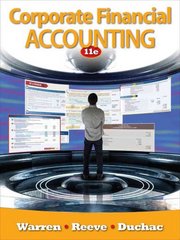Question
Historically, Ericson had been the low-cost producer of vanilla and chocolate ice cream and enjoyed profit margins over 20% of sales. Several years ago, Dennis
Historically, Ericson had been the low-cost producer of vanilla and chocolate ice cream and enjoyed profit margins over 20% of sales. Several years ago, Dennis Selmor, the sales manager, had seen opportunities to expand the business by extending the product line to new flavours that earned premium selling prices. Five years earlier, Ericson had introduced strawberry ice cream, which required the same necessary production technology but could be sold at prices that were 3% higher than vanilla and chocolate. Last year, the company introduced mocha-almond ice cream, which it could sell at a 10% price premium.
However, Laura Tunney, the controller of Ericson, was disappointed with the most recent quarterly financial results of the factory's operations. The new strawberry and mocha flavours were more profitable than the high-volume, commodity vanilla and chocolate flavours as expected, but operating margins overall had decreased, and the company was now operating at a loss. Tunney wondered whether the company should continue to deemphasize the commodity products and keep introducing new specialty flavours.
Jeffrey Donald, Ericson's manufacturing manager, commented on how the introduction of the new flavours had changed his production environment:
Five years ago, life was a lot simpler. We produced just vanilla and chocolate ice cream in long production runs, and everything ran smoothly, without much intervention. Difficulties started when we introduced the strawberry flavour. We had to make more changeovers to stop production of vanilla or chocolate, empty the vats, clean out all remnants of the previous flavour and then start the production of the strawberry flavour. Making chocolate was simple - we did not even have to clean out the residual from the previous run if we just dumped in enough chocolate syrup to cover it up. For strawberry, however, even small traces of other flavours create quality problems. Moreover, because mocha-almond contains nuts, to which many people have severe allergic reactions, we have to do complete sterilization of the vat after every mocha production run.
We are also spending a lot more time on purchasing and scheduling activities and just keeping track of where we stand on existing, backlogged, and future orders. The new computer system we got last year helped a lot to reduce the confusion. However, I am concerned about rumours that even more new flavours may be introduced shortly. I do not think we have any more capability to handle further confusion and complexity in our operations.
Ericson's indirect expenses (about $1.8 million per quarter) were comprised of the following:
Expense category
Expense (000)
Indirect labour
$ 600
Fringe benefits
480
Computer systems
300
Machinery
240
Maintenance
120
Energy
60
Total
$1,800
Ericson uses a simple costing system. The plant's indirect expenses ($1.8 million) were allocated to products based on each product's direct labour cost. The cost system's current overhead rate was 300 % of direct labour cost. Most people in the plan recalled that not too many years ago before the new specialty flavours (strawberry and mocha-almond) had been introduced, the above rate was only 200% of direct labour cost.
Ericson's production environment, however, has changed. Because of automation, direct labour costs have decreased and indirect expenses increased. As the custom, low-volume flavours have been added, Ericson needed more scheduling, setup, and quality control people, plus a computer to track orders and product specifications.
Part One: Ericson's traditional costing system was adequate for the organization when they were producing only chocolate and vanilla. Provide justification for why this was appropriate at the time and the benefits of this costing system for the organization and management.
(5 marks)
Part Two: What problems has Laura Tunney identified that make her question the appropriateness of the traditional costing system, given the introduction of the new flavours? Why might these changes affect the suitability of the legacy costing method?
(8 marks)
Part Three: Given the indirect costs provided in the chart and the description of the operations provided by Jeffrey Donald, what are two possible activities that might be used to accumulate and allocate costs. Please ensure that you justify your answer.
(4 marks)
Step by Step Solution
There are 3 Steps involved in it
Step: 1

Get Instant Access to Expert-Tailored Solutions
See step-by-step solutions with expert insights and AI powered tools for academic success
Step: 2

Step: 3

Ace Your Homework with AI
Get the answers you need in no time with our AI-driven, step-by-step assistance
Get Started


